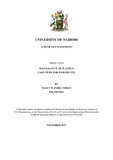| dc.description.abstract | This thesis focuses on tracking the movement of plastic materials within the City County of Nairobi (CCN) in order to establish the mass quantities of plastics that enter within, where they flow, how they are transferred and where they finally end up. In so doing, identify if there is a problem of pollution by accumulated plastic wastes, and if so, show the point at which it occurs. The objectives were to compile industrial production and waste quantities of various types of plastics, quantify the accumulation and transfer terms useful in writing mass balances and provide data and recommendations that can inform and motivate policy changes so that environmental problems caused by the plastic wastes are reduced
The spatial scope of the study was city-wide for CCN and time, the year 2011. The study established the imports were the entry points for plastic materials, the processes that plastics undergo, namely manufacture, retail, waste disposal and recycle. The study explored the flows and transfers plastics are subjected as retail, plastics waste generation, collection, diversion as well as the exits via exports, resale and disposal. The institutions acting at various processes and transfers in the plastics sector and their roles were established.
Data was collected through administration of questionnaires as follows: - 30 plastic products manufacturers whose age range is 7-44 years, 89 retailers whose age varied from start-ups to 30 years old and 55 recyclers who were 2 years old on average. Data on plastic wastes was obtained from City County of Nairobi (CCN). Key Informant Interviews were conducted with key plastics sector players on relevant standards, policies and operations such as National Environment Management Authority (NEMA), Kenya Association of Manufacturers (KAM), Kenya Bureau of Standards (KEBS) and the Kenya National Cleaner Production Centre (KNCPC). The collected data was analyzed, collated for use in establishing the quantities of common plastic resins imported into the study boundary, to track their flows and transfers through retail, recycle, collection and disposal within a given time period. Mass balances for the movement of the plastics within Nairobi City were developed.
The results of the study established that overall; manufacturers imported 2,437,419 kg of plastics per week. These were manufactured into products comprising the seven common plastic resins namely, 15% Polyethylene Terephthalate (PET, PETE), 21% High Density Polyethylene (HDPE), 16% Polyvinyl Chloride (PVC), 19% Low Density Polyethylene (LDPE), 24% Polypropylene (PP), 1% Polystyrene (PS) and 4% others. Of this production,
manufacturers sold 42% (1,027,525 kg/week) to retail in Nairobi and 58% were sold outside the study boundaries. Plastic products manufactured from the resins were in categories of finished consumer products (62%), plastic packaging (24%), and raw materials for other products (8%), carrier bags (3%) and others (3%).
Retailers obtained 164, 419 kg/week from manufacturers. This is 16% of what the manufacturers sold into Nairobi. The sharp loss (84%) in transfer accountability is attributed to the fact that some of manufactured plastics products such as packaging (24%) and raw materials (8%) are not recognized as plastic materials but rather as commodities in retail. Also, manufacturing occurs in a centralized zone with production data in bulk quantities is recorded in mass while on the other hand, retail is city-wide with much less numbers in sales data recorded as items and rarely in mass quantities.
Plastic wastes generated were 1,352,156 kg/week. This increase in waste generation compared to retailed quantities was attributed to the fact that plastic packaging lost during retail re-enters the waste stream recognized as plastic material. 383,739.04 kg/week (33%) of plastic wastes generated were collected in mixed resins and disposed by CCN. 62,469.15 kg/week (14%) of the generated plastic wastes collected by CCN was diverted to recycling. Overall, 393,462.89 kg/week was recycled by recycling enterprises including their own collections within the study boundary.
It was found that, of the 1,027,525 kg/week plastics that entered the study boundaries, 383,739.04 kg/week (37%) was removed through collection by CCN to final disposal and 393,462.89 kg/week (39%) was removed through informal, private-owned recycling enterprise. 250,323 kg/week (24%) of plastics were not removed. These are the therefore the ones that accumulate and cause pollution problems.
The study reveals the need for good quality plastics material data collection, the need to identify data management institutions and the opportunity provided by privately owned plastic recycling enterprise in removal of plastic wastes. The study recommends that authorities seize this opportunity to offer incentives to these private sector enterprises in order to increase removal of plastics wastes and further reduce pollution | en_US |

